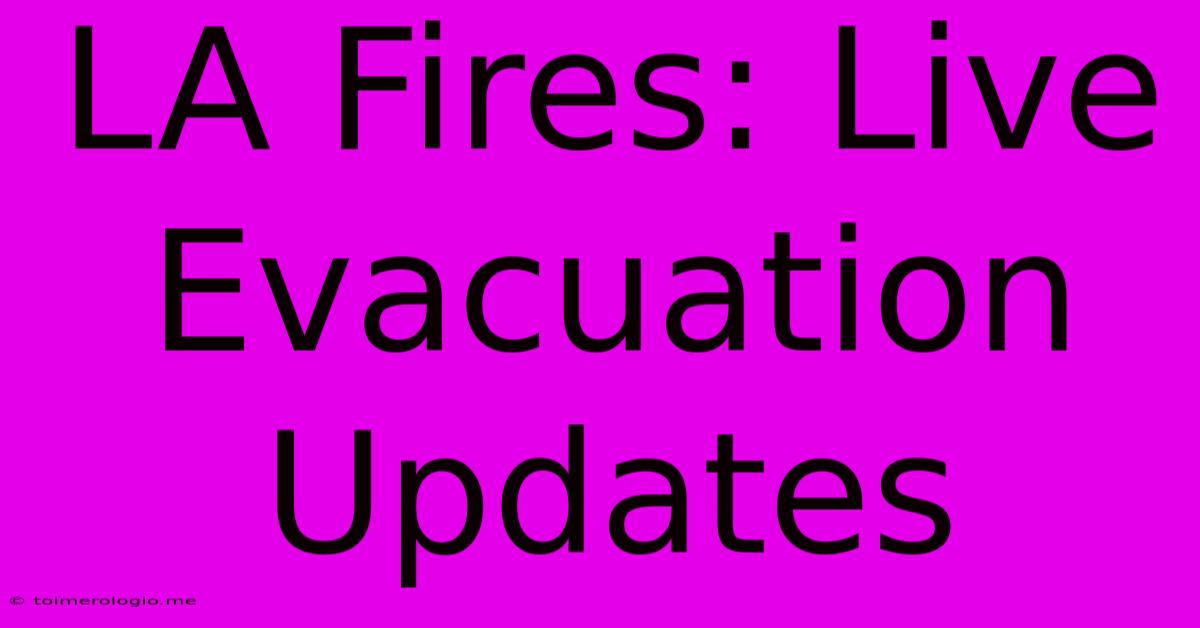LA Fires: Live Evacuation Updates

Discover more detailed and exciting information on our website. Click the link below to start your adventure: Visit Best Website toimerologio.me. Don't miss out!
Table of Contents
LA Fires: Live Evacuation Updates & Safety Information
Southern California's wildfire season is a recurring threat, and Los Angeles is unfortunately no stranger to the devastating impact of these blazes. Staying informed during an active fire event is crucial for safety and survival. This article provides up-to-the-minute information (as much as possible for a static document – always check official sources for the most current updates) and essential resources to help you navigate LA fires and evacuations.
Understanding the LA Fire Risk
Los Angeles's unique geography, with its sprawling urban areas nestled against wildlands, creates a high-risk environment for wildfires. Factors like Santa Ana winds, dry brush, and increasing temperatures exacerbate the threat, leading to frequent and often unpredictable fire outbreaks.
Types of Fires in LA:
- Wildfires: These are uncontrolled fires that spread rapidly through natural vegetation, often fueled by dry brush and strong winds. They pose the greatest threat to life and property.
- Structure Fires: While often unrelated to wildfires, structure fires can occur simultaneously or be sparked by wildfires, further complicating evacuation efforts.
- Brush Fires: Smaller fires that primarily affect undeveloped areas. However, these can easily escalate into larger wildfires under the right conditions.
Real-Time Evacuation Information Sources:
During an active fire, reliable information is paramount. Do not rely on social media for official updates. Instead, consult these primary sources:
- Los Angeles County Fire Department (LACoFD): Their website and social media channels (check for verified accounts) provide crucial updates on active fires, evacuation orders, and road closures.
- Los Angeles City Fire Department (LAFD): Similar to LACoFD, LAFD offers real-time updates specific to city boundaries.
- Nixle: This free alert system sends emergency notifications directly to your phone. Sign up for your area.
- Emergency Alert System (EAS): Your television and radio will broadcast EAS alerts during emergencies.
- Local News Stations: Keep your radio or television tuned to local news for ongoing coverage and updates.
What to Do During a Fire Evacuation:
1. Stay Informed: Constantly monitor official sources for evacuation orders, road closures, and shelter locations.
2. Develop an Evacuation Plan: Before wildfire season, create a family evacuation plan. This should include:
- Escape Routes: Identify multiple escape routes from your home, considering potential road closures.
- Meeting Point: Designate a safe meeting place outside your home, away from the fire zone.
- Emergency Kit: Prepare an emergency kit with essential supplies like water, food, medications, important documents, and a first-aid kit. Consider pet necessities too!
- Communication Plan: Establish a way to communicate with family members in case of separation.
3. Evacuate Immediately: When an evacuation order is issued, leave immediately. Do not wait for the fire to approach. Traffic will be heavy, so the sooner you leave, the better.
4. Drive Safely: Be aware of smoke, reduced visibility, and potential hazards on the road. Follow directions from emergency personnel.
5. Shelter in Place (Only if Instructed): Sometimes, evacuation might not be possible immediately. If instructed to shelter in place, follow these guidelines:
- Close windows and doors: Seal any gaps to prevent smoke from entering.
- Turn off air conditioning: Avoid drawing in smoke.
- Stay indoors: Only leave if absolutely necessary.
Post-Evacuation: Returning Home Safely
Before returning home, check for official announcements lifting evacuation orders. Even after the order is lifted:
- Be aware of hazards: Fallen power lines, unstable structures, and hazardous materials could still pose risks.
- Inspect your property: Check for damage and report any issues to the appropriate authorities.
- Clean up carefully: Dispose of hazardous materials appropriately. Wear protective gear when cleaning up debris.
Protecting Yourself and Your Property
Beyond immediate evacuation, proactive measures can help mitigate wildfire risks:
- Home Hardening: Create defensible space around your home by clearing brush and flammable materials.
- Fire-Resistant Landscaping: Use fire-resistant plants in your landscaping.
- Regular Maintenance: Keep your gutters clean and remove dead branches from trees.
- Emergency Preparedness: Regularly update your emergency kit and review your evacuation plan.
Key Terms to Know:
- Evacuation Order: A mandatory order to leave an area due to imminent danger.
- Evacuation Warning: An advisory to prepare for potential evacuation.
- Defensible Space: The area around a structure that is cleared of flammable materials to protect it from wildfire.
- Red Flag Warning: A warning issued by the National Weather Service indicating a high risk of wildfire due to critical fire weather conditions.
Staying Updated is Crucial
Remember, the information provided here is for general guidance. Always rely on official sources for the most accurate and up-to-date information during a fire emergency. Your safety and the safety of your loved ones depend on it. Being prepared is the best way to protect yourself and your community during the challenging wildfire season in Los Angeles. Staying informed and following evacuation orders is key to surviving and minimizing losses. Be safe!

Thank you for visiting our website wich cover about LA Fires: Live Evacuation Updates. We hope the information provided has been useful to you. Feel free to contact us if you have any questions or need further assistance. See you next time and dont miss to bookmark.
Also read the following articles
| Article Title | Date |
|---|---|
| Ventura Riverbed Facing Brush Fire | Jan 15, 2025 |
| Ventura County Fire Near Oxnard Burns | Jan 15, 2025 |
| Late Goal Denies Man City Win At Brentford | Jan 15, 2025 |
| Major Fire Near Oxnard Ventura County | Jan 15, 2025 |
| Epl Profit And Sustainability Rules Avoided | Jan 15, 2025 |
